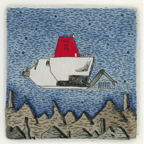 What's Happening Today - May 18
What's Happening Today - May 18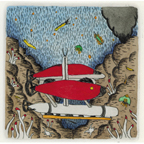
 What's Happening Today - May 18
What's Happening Today - May 18
Today was Paul Johnson's first Alvin dive. Here are his thoughts on what it was like going to the bottom of the ocean.
-----
For almost the last 10 years I have been mapping the seafloor during research cruises while bobbing about on a ship on the surface. This meant when I was invited to go out on this cruise to participate on an Alvin dive I jumped at the chance. On most cruises that I go on we use sonar systems that map features from the scale of underwater mountain ranges to the scale of small volcanic fissures and the lava flows they produce. However, to finally be able to correlate what I see on the maps with what is actually there was too good a chance to pass up.
As we were climbing down the ladder into Alvin yesterday morning all I could think was - wow this is finally happening!. The hour and a half descent went by much faster than I thought it would and next thing you know there, illuminated in the lights of Alvin, was the seafloor. The first thing that passed through my head was: "hey it looks like the volcanic terrains of Hawaii". However, once we came upon the 1st hydrothermal vents, I knew that I was truly in a very different environment. The next 4 plus hours looking at volcanic fissures, lava flows, vents, and all sorts of strange creatures went by in almost a blur. Even when my body began to complain of the odd contortions you are forced to do to look out the windows of Alvin I still didn't want to pull myself away from the window for fear of missing something. At the end of the dive, as we were rising towards the surface, my thoughts were "I really want to do this again". Being able to see the relationship between what our maps of last November show and what the seafloor is actually like should greatly help me interpret maps in the future. Thanks, Dan, Hans and Maurice!
- Paul Johnson
-----
ABE was successfully launched and is on it's way to the bottom to map the seafloor west of the ridge axis for the next day. We will pick it up tomorrow evening before we head south for the Galápagos. We also tested the towed camera/corer system, but with mixed results. There was a leak in one of the camera connectors which caused the camera and strobe to not work. But we learned a lot about the corer winches and Steve Liberatore and Andy Billings are going to work on the system more tomorrow to fix various problems. We're confident we'll get it running well soon.
Best Regards,
Dan
Al Bradley (left) working on repairing ABE. Al Duester fights off the 'Killer Rabbit'.
Pat Hickey, the Expedition Leader, looks on as Rhian Waller examines some samples in the microscope.
Eric Olson and Rhian Waller didn't have enough to do today so them made a blow-up figure of Dan sitting at his computer in the main lab... or is that the 'real' Dan !
Carl Wood, the Steward, and expert Alvin swimmer calling down to the Pilot after today's dive to see what folks want for supper..., actually he's discussing the recovery process with the pilot. Many of the ship's crew help with all aspects of Alvin launches and recoveries.
The feet in the pool belong to Paul Johnson, who was ceremoniously dunked by Blee Williams, one of the Alvin pilots, after Paul's first Alvin dive. Paul also had some trouble locating all his boxer shorts after the dive... this pair somehow made it into the -70°C freezer.
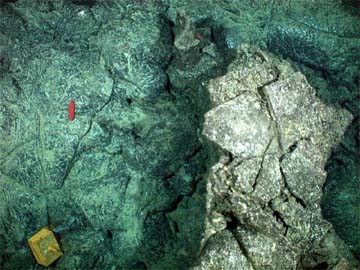 Bottom photograph showing lobate
lava and an old Alvin weight (lower left) and a red sea cucumber
(holothurian). Scale across the photograph is approximately 6
meters.
Bottom photograph showing lobate
lava and an old Alvin weight (lower left) and a red sea cucumber
(holothurian). Scale across the photograph is approximately 6
meters.
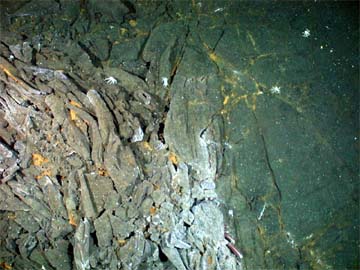 Curtain folded lava with white
bacterial mats caused by low temperature hydrothermal venting.
If you look closely at the bottom middle edge of the photo, you
can see two young tubeworms living in the crevice of the flow.
The small white spider like animals are galethid crabs, common
near hydthrothermal vents. Scale across the photograph is approximately
5 meters.
Curtain folded lava with white
bacterial mats caused by low temperature hydrothermal venting.
If you look closely at the bottom middle edge of the photo, you
can see two young tubeworms living in the crevice of the flow.
The small white spider like animals are galethid crabs, common
near hydthrothermal vents. Scale across the photograph is approximately
5 meters.
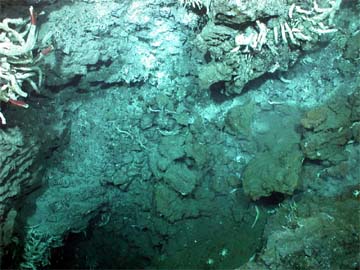 One of the low temperature hydrothermal
vents where we slurped white bacterial matter for the TIGR researchers,
Naomi and John. Scale across the photograph is approximately 4
meters.
One of the low temperature hydrothermal
vents where we slurped white bacterial matter for the TIGR researchers,
Naomi and John. Scale across the photograph is approximately 4
meters.
Naomi Ward working on dissecting a tube worm collected on today's dive. Rhian Waller has brought cups made by Ann Varley's students in Bath, England to be shrunk during our Alvin dives.
The towed camera system being lowered this evening for it's test.